You can stare at analytics and metrics all you want. But it won’t grow your app or move the needle.
Thankfully, you can do more than stare. There are actionable ways you can improve your platform’s success. All it takes is understanding what to measure, who to measure, and how to implement those insights.
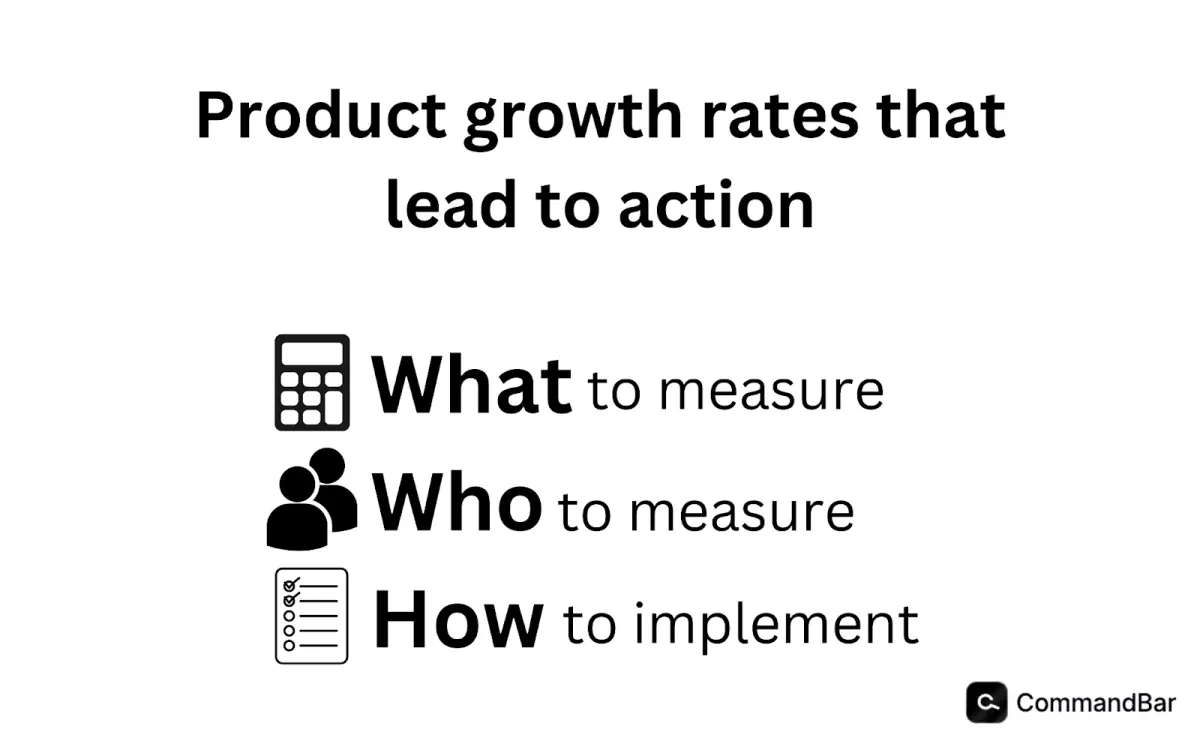
Product growth rate helps leaders assess how a SaaS platform performs and how to improve it.
The biggest mistake is when companies measure product growth like a big pot of chili. They throw everything in there, stir it, and add cheese at the end, and it’s all good. But that’s not how product growth works.
You can’t put all users into one group. They each have unique needs and drives, and they value different experiences.
Product growth rates should be measured by audience and market segments. Then, companies need to put what they learn into action. Brands can improve product growth through “selfless” strategies that prioritize existing customer needs first instead of their own.
What is the product growth rate, and what is the formula?
A company’s growth rate can relate to many different things—recurring revenue, churn rate health, new users, and other insightful metrics based on your app benchmarks. It’s up to you to figure out in what areas you want to grow your product.
You can then calculate growth rate by subtracting a current period metric from the past period metric. Next, you divide the total by the past period. Finally, you multiply it by 100.
Let’s imagine that framework with product growth focused on revenue:
(Revenue within a current period - Revenue in the last period) / (Revenue in the last period) X 100
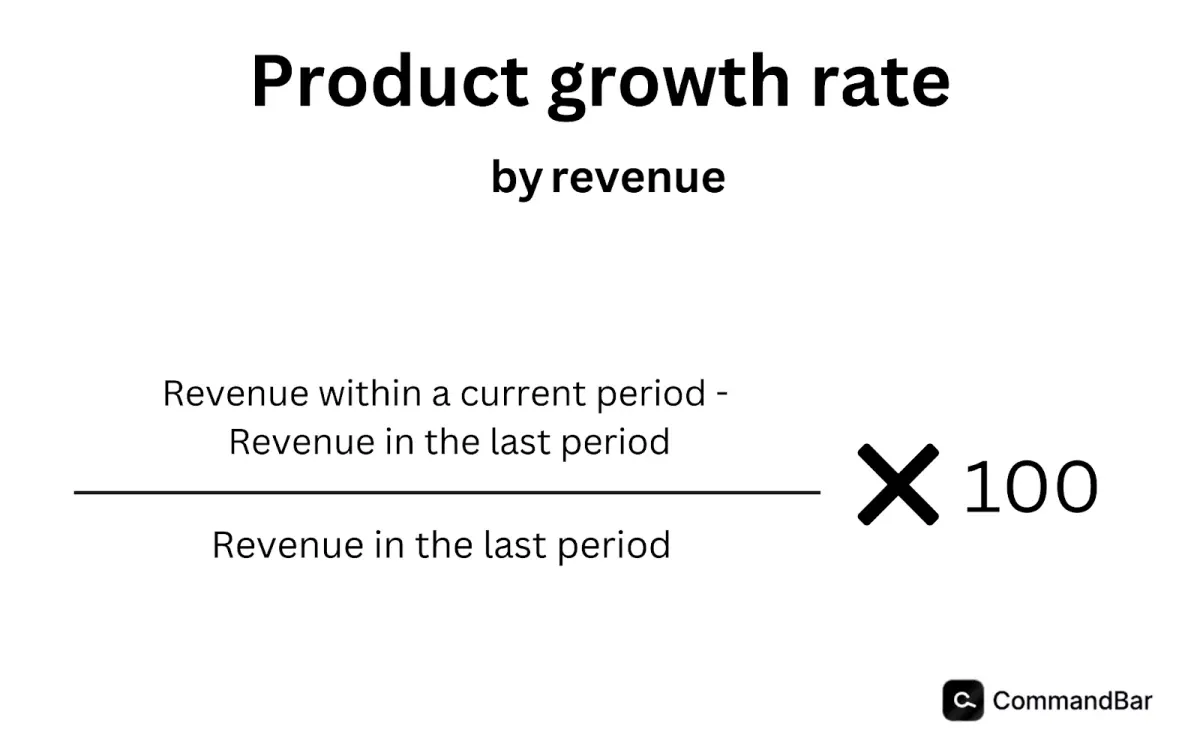
You can do the same by switching out new users or retained users. Then, establish a metric for product growth based on those benchmarks.
Good growth rates: What should you be aiming for?
Product growth looks different for everyone.
A bootstrapped startup has different standards (advantages and disadvantages) than a venture-funded startup. A social media company will expect and need numbers different from those of a B2B enterprise SaaS platform business.
Not only do industry circumstances make a difference, but so do economic growth and market growth environments. These are considerations when companies are developing growth rate calculations.
Because of these differences, there’s no average growth rate across the board. But there are accurate industry-specific averages you could use as a benchmark within your network.
But more importantly, companies should create goals for progress. They need to identify where they are now and what it will take to reach the next ideal product growth level.
Yeah, but what is it really? How companies fail
Unfortunately, growth and user adoption strategies are often self-serving.
In the Command AI manifesto, CEO James Evans elaborates on the “selfish” problem:
“The same way [popups] were first built to the benefit of advertisers and the detriment of users, digital adoption is built to the benefit of product teams and the detriment of users.”
The key to a successful product growth rate is to make your strategy 100% about the user. Serve their needs, provide intuitive onboarding journeys and experiences, and give them the desired value. You’ll guarantee a scalable and sustainable revenue growth rate.
First, you should understand your audiences to create a "selfless" experience. This isn’t your typical “know your target audience” plug—I’m not promoting a book on The Tonight Show.
This is more intimate. It’s a deeper strategy. I’m talking about knowing each of the dozens of different types of users.
Users find your app in many different ways and have different expectations once they sign up for your solution. Different drives like needs and behavioral habits influence user experiences. A one-size-fits-all approach won’t get you far in a long-term sustainable growth strategy.
Measuring by segment: Sourcing contextually relevant data in a sea of metrics
You can discover users’ needs and deliver personalized experiences by segmenting your audience.
Stop measuring growth through one big group of users to turn insights into action.
Measure by segment.
Overall growth rates can hide emerging trends, such as particularly high- or low-growth groups. You can spot these shifts by segmenting audiences when you calculate the rate above.
That leads to the first step: Identify user acquisition channels. Customers find your app in different ways. This can reveal their buy-in for your solution and what they expect from the app, which can provide important insights for onboarding and user experiences.
For example, there’s a big difference in user intent between someone finding an app on Product Hunt versus searching for a keyword. In the first method, users actively look to try something new. They see customer ratings and social proof.
Someone searching on Google, on the other hand, might not have the same excitement or interest in trying a new product—they just want to solve their problem fast. How you approach those segments matters, especially in the first three minutes of login.
Second, identify common user behavior traits. Different groups will use certain features, vary in usage rates, and reveal frustration points that help you find opportunities to improve.
Let’s say you have more than one use case or target audience, like a video tool that engineers and teachers both like to use. They have different needs and will favor different features. They’ll also have different preferences and frustrations you can address for a better app experience.
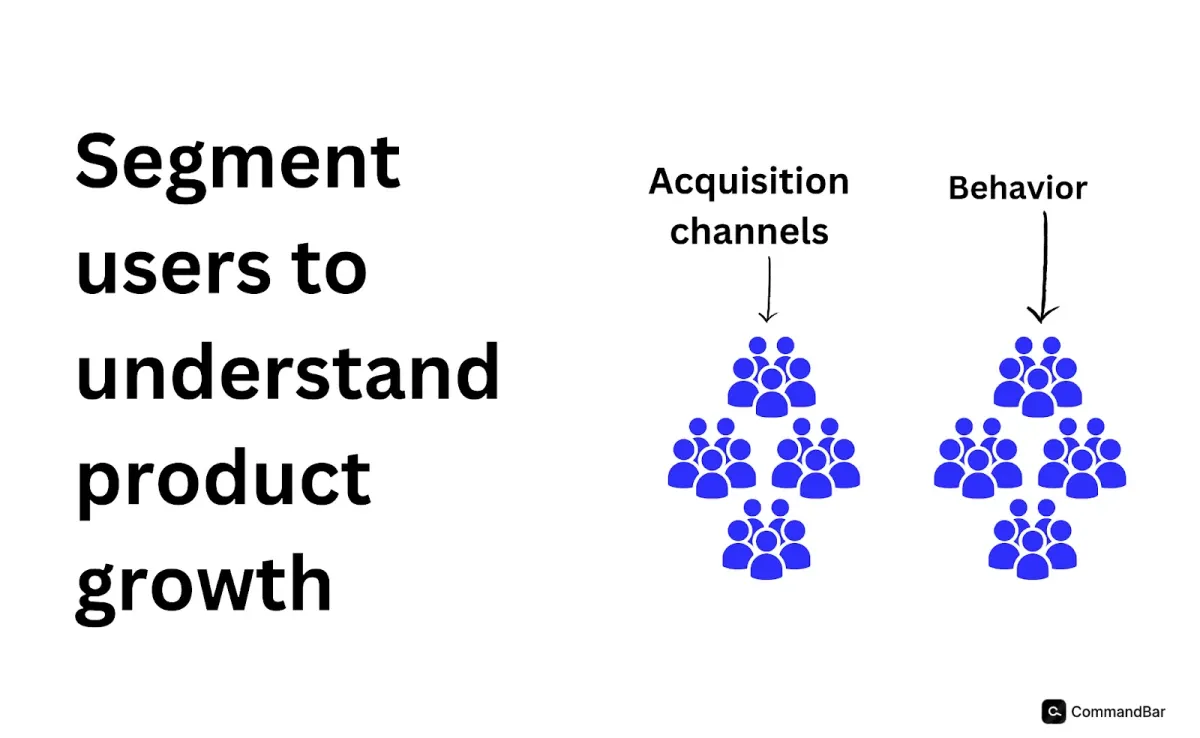
These examples emphasize that one of your most essential segmentations will be use case needs.
After a customer tells you why they need your app through an onboarding survey, you know what they want. You can then start with the feature they actually need. This is how it should work. But sadly, most onboarding experiences aren’t tailored. You can use survey information to study how each segment uses your app throughout the customer lifecycle. That helps identify any drops in usage based on periods and more.
So don’t get flustered when dealing with hundreds of different metrics.
Put a face to it.
The more you can understand each segment’s needs, habits, and learning preferences, the easier it is to serve your audience.
Attract and retain: Must-have strategies for better product growth
When companies think of product growth, marketing and sales inevitably come first. But before any brand invests in a strategy, it should ensure that the product can fulfill its promise and that each user gets exactly what they need.
Not only is an informed approach better for onboarding and customer adoption, but it’s also beneficial when brands know exactly how to communicate and promote the product per target audience segment.
This approach improves retention so that the new users you attract stay, providing sustained long-term revenue growth.
Making growth about the user
You can kick off your product growth plan by prioritizing user-centric optimization.
Writer Vikas Agrawal elaborates in a Forbes article: “[Product-led growth] is reshaping the SaaS landscape by focusing on user-centricity and instant gratification, leading to higher conversion and retention rates...[Product-led growth] is all about letting users experience your product firsthand and allowing its value to speak for itself.”
This is why audience segmentation is critical. You can only give users immediate value if you know what they need.
Companies should meet needs as soon as possible. When new users sign up for an account in an app, they should receive a quick survey informing them why they need it. Then, the customer goes through a personalized product tour. It leads to the aha moment the user’s been looking for.
If a customer wants to convert a file and signs up for a SaaS that offers the feature, they should get it immediately. Instead, if the onboarding process forces the customer to learn about design, the company is doing a disservice to the user. As a result, that customer is more likely to abandon the app.
Throughout the user journey, you can provide the experience everyone wants but rarely gets. Get rid of annoying and intrusive popups. Instead, create an experience where users get nudges that gently point them in the right direction.
Another example is adding tooltips to provide information about key features. Users can quickly learn more through a resource hub or message a live chat assistant. More customers prefer user-centric, familiar, and pleasant experiences over frustrating, forced journeys.
Part of making personal experiences possible is obsessing over each customer’s need and finding the best way to provide what they need.
These approaches led to SaaS solutions like Orbus, which invested heavily in personalized cloud transformation for enterprise brands. This led to a 56% platform growth since it adopted a subscription model only three years ago.
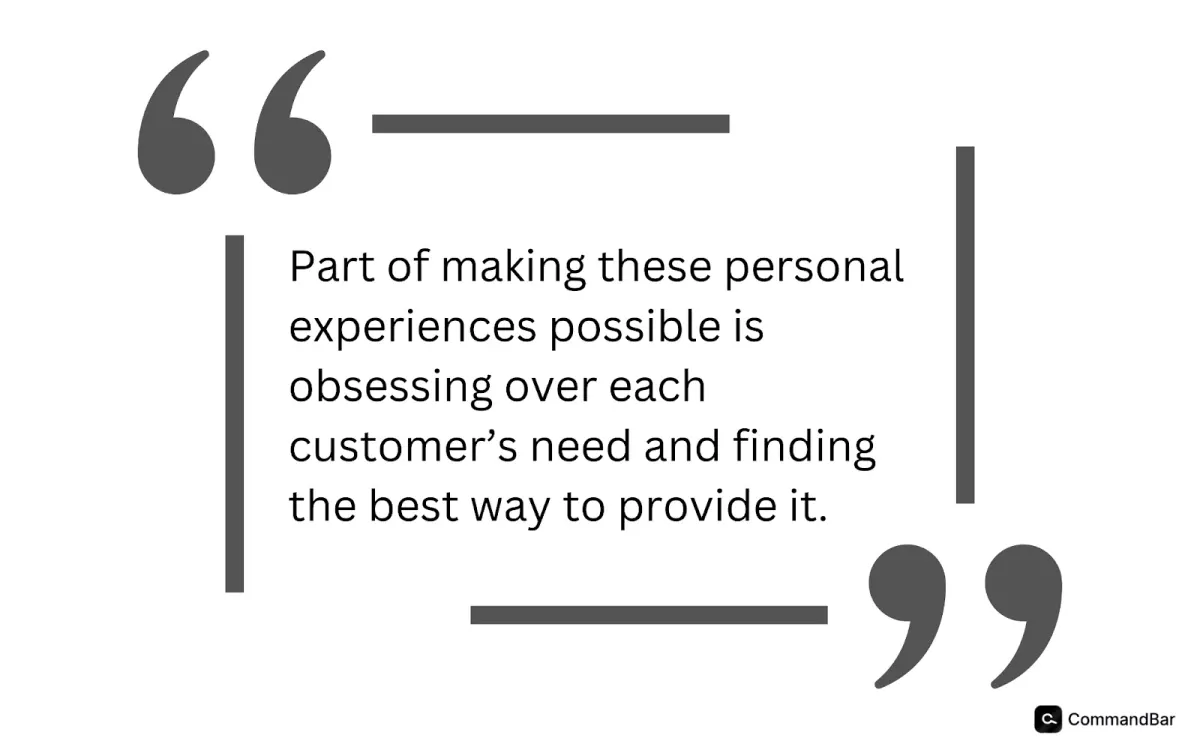
Personalization built on data and support
Personal approaches to onboarding, customer support, and user experiences offer a better strategy. Users should be able to chat with AI, find the right resources, and provide in-app feedback to get the most out of your app.
In the best case, customers get what they need immediately. If they don’t right now, a tight feedback loop through your feedback channels can ensure it doesn’t happen again by informing you of the situation.
These experience opportunities are tied into data-driven experimentation. For example, you can start with customer support deadends.
If a user looks for an answer to an issue or a feature through your universal search but can’t find it, this immediately provides you with helpful information. This data type can reveal frustrations, shifting trends, and needs within your app.
For one, if a customer has a problem and no resources to help them solve it, you can change the situation. If it’s a frustrating bug, you can fix that issue within the app. Or, if it’s a matter of information support, you can add the content to your help resources.
But what’s especially valuable for future growth is identifying evolving needs. You may notice growing interest in a certain feature or capability. Eventually, you can add that feature and grow market share with your audience by servicing more relevant and vital needs.
Through other forms of data, like new users, feature usage, and customer adoption, you can begin to measure growth, find opportunities for improvement, and scale your app.
Nurturing audiences and your brand reputation
Finally, it’s a good idea to work hard to build authority. By providing high-quality personal experiences, you can establish a reputation for great products, stellar customer support, and top user experiences.
Once you establish a robust customer retention solution by fulfilling user needs and providing end value with a personal app experience, you can move forward. You can confidently attract new customers, knowing they’ll continue to pay for your SaaS for the long haul.
Why slow growth does not mean failure
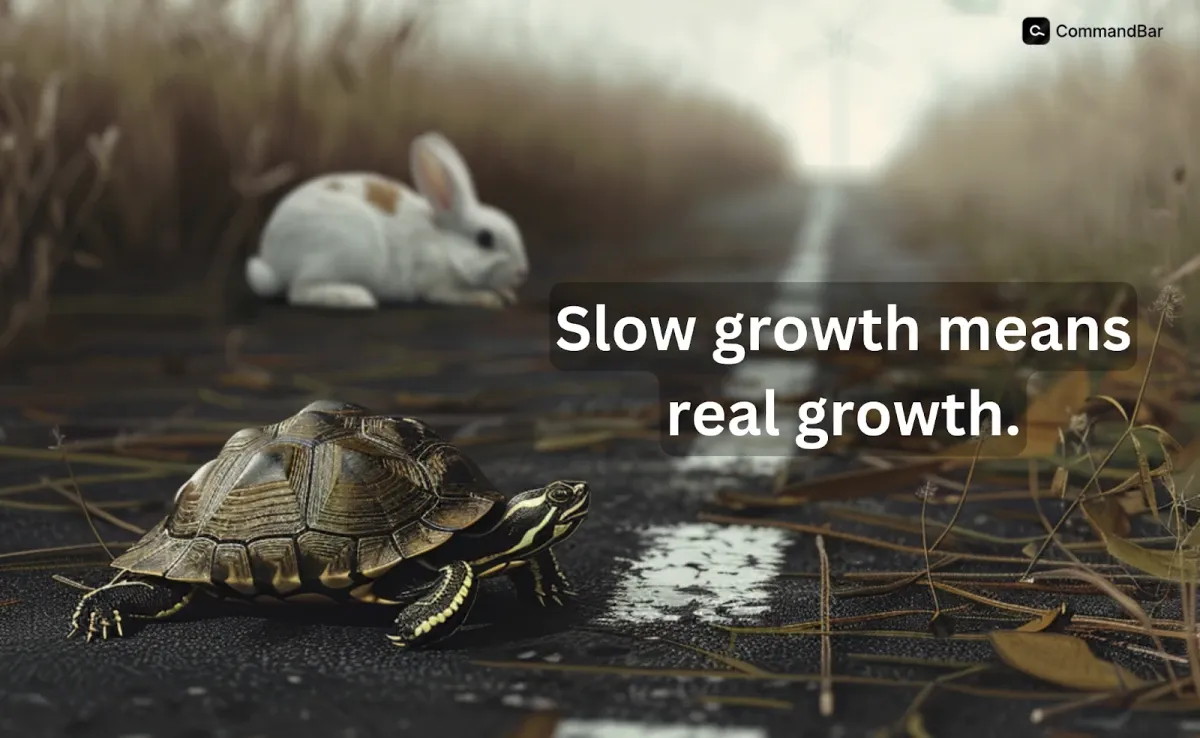
You hear it all the time: easy come, easy go. In other words, things that happen fast often disappear fast. And there’s some truth to that.
When you move too fast, you don’t have enough time to create a solid growth foundation.
You miss the details that matter.
So, while you may benefit in the short term, things seem to fall apart when the economy changes or a competitor emerges.
Slow growth, on the other hand, often leads to long-term gains. Most can agree that they want healthy companies that won’t disappear in a few years.
Slow growth allows you to intimately know your audience and add the right features at the right time to meet users’ needs. Plus, you can optimize a tight feedback loop and continually improve, building an agile, resilient, and scalable company one brick at a time.
You improve user retention by taking the time to build a product and provide the experience each customer segment needs. And that’s the primary key to product growth.
If you can keep your existing customers, you can invest in attracting new users, knowing that growth actually means growth. You’re not Jack Sparrow on Pirates of the Caribbean sinking with the ship; there’s no leak in the ship. Each new customer leads you closer to the growth milestone.
Leveraging tech to supercharge product growth
It’s impossible to scale over the long term without the right tools.
You need the solution to collect user behavior information, receive user feedback, analyze the data, and deploy the necessary features to serve your customers. More importantly, you need a platform that can offer personalized, familiar experiences.
There are many tools for each task, but it’s hard to find one that can do it all. Instead, companies juggle many solutions that either don’t talk to each other or produce conflicting outcomes. Imagine getting data from one tool with vague parameters and methodologies for metrics and trying to harmonize it with another tool’s dashboard. Or, dealing with data delays because of manual processes.
Using a bunch of disconnected solutions, of course, makes it way harder than necessary to try to hit growth goals. Not to mention that it often results in forced experiences that frustrate users and send them running for the hills.
Tools like Command AI replace distracting popups with nudges that gently point users in the right direction. Users who sign up for your app try the exact use case they need. And what if a customer searches for something you don’t have? You can access that insight and act immediately to remove deadends that hurt user experience.

The more you understand your users and implement changes based on your findings, the more successful you’ll be at creating a positive growth rate. The difference is doing it the right way through personalized experiences and customer segmentation with the features that make it possible.

















